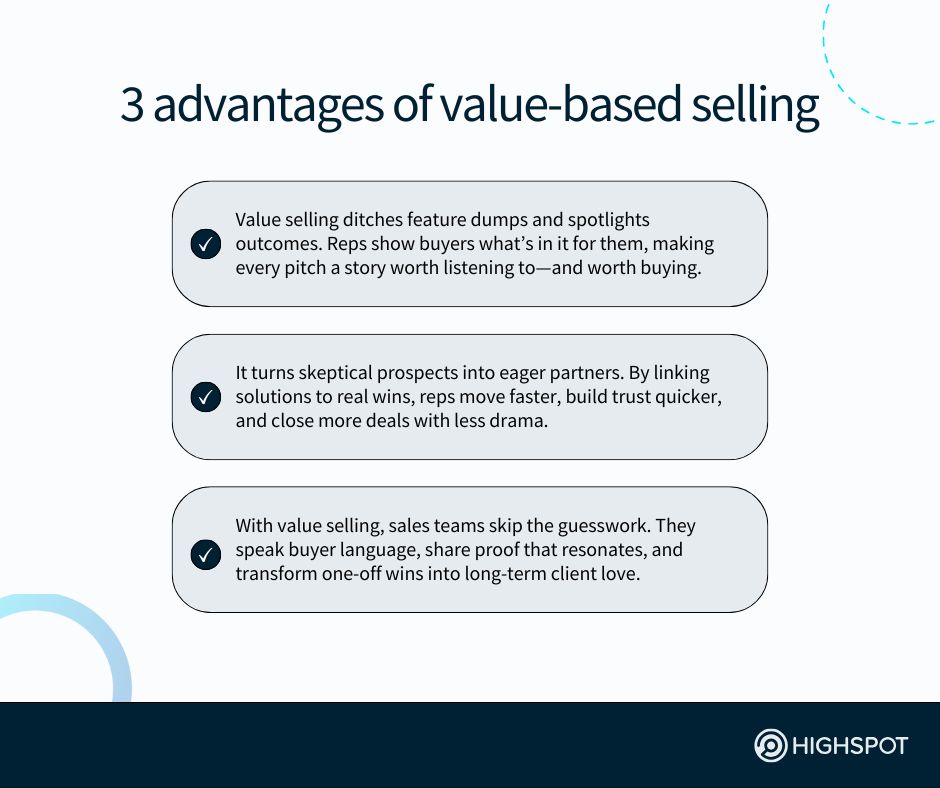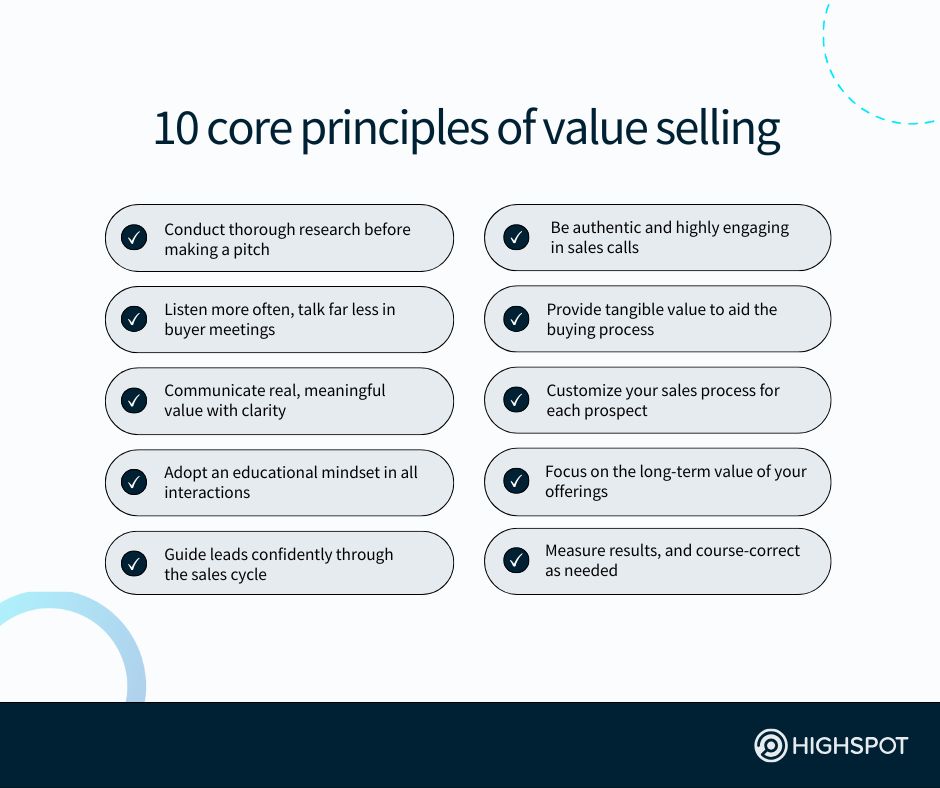Key Takeaways
- Value selling flips the script. Sales representatives shift from pitching products to proving impact. It’s all about helping buyers connect the dots between business goals and what your solution delivers.
- Today’s B2B buyers want real insight, not rehearsed lines. Value-based selling guides prospects with smart questions, tailored advice, and proof points that show reps are more partner than pitch machine.
- Great sellers highlight notable features and solutions, but they also connect the dots to business outcomes. With value selling, reps simplify the complex, speak the buyer’s language, and make decisions easier.
When your buyers are in research mode, they don’t want an overt and blatant product pitch. Rather, these key decision-makers want a strategic partner who gets their world, speaks their language, and can guide them to a better future.
That’s where value selling (a.k.a. value-based selling) can help.

What is value selling?
Value selling is a sales method that focuses on demonstrating the real-world outcomes your products or services offer—an influential factor in buyers’ decision-making. The opposite of a feature-based selling approach, value selling highlights benefits tied to a customer’s needs, as opposed to feature-based selling.
This proven, value-based approach positions your offerings as the ideal solution and the right fit for leads by aligning directly to prospects’ pain points. It works because the value proposition is front and center, giving sales reps a clear, consistent sales playbook to build trust with buyers and communicate strong ROI.
Value selling is the other side of the consultative-selling coin, but with more energy and punch. You engage purchasing decision-makers—including C-suite executives and technical personnel—on sales calls, via email, and in other channels to outline long-term benefits of your products or services succinctly.
Done well, this value-based selling framework helps your sales reps buy-in from buying committee members, make a compelling case to financial stakeholders at high-value accounts, show how similar customers win with your business, and—ultimately—close more deals with leads that turn into satisfied clients.
How value selling differs from consultative selling
The value-based selling approach focuses on proving outcomes. Consultative sales emphasizes asking questions and diagnosing needs. The two overlap, but value selling takes it further by attaching hard business impact to every solution.
Think of the consultative sales methodology as the curious doctor running tests and asking about your symptoms. The value-selling approach is the prescription with proof it’ll cure your headache, boost your energy, and make you feel better. It’s designed to convince buyers that your offer is both relevant and revenue-ready.
Sales reps who master value selling don’t just nod along with empathy. Instead, they show how similar clients solved the same struggles and walked away with the desired results.
That’s how you and your sales team show you’re attuned to the wants, needs, and challenges of the potential customer’s business and convert them to closed-won.
What makes value-based selling important for reps
Value-based selling is vital because it connects what you sell directly to measurable customer outcomes. Sales reps who lead with value and show genuine interest in the problems that prospects want to solve consistently shorten sales cycles, speed up sales velocity, win more deals, and create lasting loyalty.
This value-based approach gives reps the:
- Clarity to show how their solution fits
- Courage to stop chasing the wrong leads
- Creativity to prove ROI in ways that matter
Simply put, value selling transforms a sales call into a story where the lead is the hero and the product is the sidekick. It helps your sales reps establish credibility, earn trust, and ensure your business ends up with satisfied clients who get maximum value (and cost savings) from your products or services.
| Use cases for value-based selling | What it looks like in action |
|---|---|
| Pitching skeptical or risk-averse financial/technical decision-makers | • Sales reps highlight proven ROI with real client outcomes and validated data points. • They focus conversations on risk reduction, compliance assurance, and measurable impact. • Stories emphasize how similar buyers avoided costly mistakes by choosing your solution. |
| Competing against lower-cost or feature-heavy alternatives | • Sales professionals shift the discussion from features to business results and growth impact. • They demonstrate how higher upfront investment leads to stronger long-term, sustainable ROI. • They unearth hidden costs of ‘cheaper’ tools and vendors that slow growth or drain resources. |
| Selling into highly complex and/or sizable B2B buying committees | • Sellers align value messages to diverse stakeholder needs across functions and levels. • They connect target outcomes to both strategic goals and tactical day-to-day priorities. • They use tailored success stories to unify decision makers around shared business wins. |
| Introducing a disruptive or new-to-market solution unknown to leads | • Sales reps frame the product as a category-shaping, future-proof investment opportunity. • They present quantified proof points that validate novelty and credibility. • They show examples of early adopters gaining significant competitive advantage. |
| Expanding the scope of deals with cross-sell or upsell opportunities | • Sellers connect new offerings directly to current customer goals and existing outcomes. • They demonstrate how expanded adoption increases overall value and efficiency. • They position additional solutions as natural extensions of proven business success. |
| Selling into industries with heavy regulation or rigid compliance needs | • Reps emphasize risk mitigation, compliance assurance, and audit-ready transparency. • They highlight certifications, governance features, and safe implementation practices. • They use examples from regulated industries to build credibility and confidence. |
| Reengaging stalled or slow-moving sales opportunities in the pipeline | • Sales team members revisit pain points with fresh ROI analysis and updated insights. • They provide new, customer-focused examples of measurable business impact. • They reframe urgency by focusing on opportunity costs of inaction. |
| Differentiating tech against point solutions in fragmented tech stacks | • Sales reps show how unified platforms drive clarity, speed, and measurable impact. • They contrast siloed point tools with an integrated, outcome-focused approach. • They detail how consolidation saves time, reduces risk, and improves decision-making. |
Why value selling is so important today
Highspot’s State of Sales Enablement Report 2025 found go-to-market leaders’ focus on improving customer value increased roughly 300% year-over-year.
Part of these GTM leaders’ sales strategy to provide more value to both existing and potential customers? Provide better sales training and coaching to reps—including teaching them how to implement a value-based selling process.
There are a handful of reasons why this sales technique is widely beloved and increasingly adopted by revenue teams at companies across industries today.
Buyers tune out when value’s not presented upfront
Buyers don’t have patience for fluff. If your sales reps open with a feature dump, the buying process grinds to a yawn. Value selling, meanwhile, transforms each sales conversation with prospective customers into moments that matter.
When you detail how your solution creates value upfront and ask open-ended questions, you hook leads’ attention and keep it. That’s how you drive home the real difference of your offerings and set yourself up to close more sales and achieve results (see: sales quota attainment) with confidence.
The buying process stretches without clear impact
Across the entire B2B buying journey, indecision reigns supreme, if impact isn’t obvious. Prospects stall, second-guess, and—worst of all—wander off to competitors.
By leveraging sales intelligence to unearth hidden needs, your sales reps can cut through the fog. Each sales engagement becomes a chance to highlight outcomes, not options.
Clear value presented to prospects early on shortens deal cycles, sharpens urgency, accelerates decisions, and helps you close deals before momentum fizzles.
Sales professionals win with a personable approach
Sales reps who position themselves as trusted consultants win hearts and wallets. In every sales engagement, personality, empathy, and insight beat cold scripts.
When reps share examples of client success stories, they turn theory into proof.
Buyers want to feel seen, heard, and valued—because that’s when they buy from you, not the sea of sameness. Anyone can share pricing sheets and product demos.
Top-performing reps share their solutions’ benefits from the perspective of their prospects and help them build financial cases for them internally.
One-size-fits-all sales pitches fall flat with leads
Generic decks, boilerplate sell sheets, and canned lines? Dead on arrival. Leads crave relevance, and thoughtful account-based selling makes it possible.
By tailoring the pitch to a company’s world, your sales reps can engage smarter and resonate deeper. Every personalized touch says, “We get you.”
That’s how you transform cold shoulders into open ears, move from forgettable to unforgettable, and set the stage to close future sales with authority.
Customer-centric approaches beat product-led ones
Product bragging feels like shouting into the void. Instead, value selling centers everything on the customer. Each sales conversation with prospective customers should focus on their world: problems, goals, risks, dreams.
Value-based selling is about showing, not telling.
Share real-world examples of your biggest clients’ success stories that prove your solution is the best solution. When your sales reps detail how your products or services create value for buyers, they prove they’re truly customer-obsessed sellers who don’t just want to close deals but also build lasting relationships.
When value-based selling makes sense
As noted, value-based selling flips the script for your sale strategy.
Instead of dumping features, you lead with insight. You ask killer questions. You show up with stories, not spec sheets. And you connect your offer to outcomes that matter. That’s why so many B2B sales teams adopt value-based selling—because it works.
But here’s the twist: The tried-and-true approach only works as long as you have the right tools and processes in place and strategy behind it. That means you must:
- Equip each of your go-to-market teams with insight-rich collateral
- Coach your sellers to navigate tough conversations with prospects
- Train reps to listen better, pitch smarter, and close with confidence
- Guide sellers on an ongoing basis—ideally using AI sales role plays
You can’t do that in a spreadsheet. That’s why your GTM teams need a unified, AI-powered sales enablement platform that helps you convert potential customers into paying clients with content that hits, plays that land, and actions that win.
With help from AI and analytics in such an enablement solution—like Highspot—your sales teams can finally scale the behaviors that matter. And because it’s all tied to outcomes, you’ll know exactly where value selling is making the biggest impact.
As long as you have cutting-edge technology like this embedded in your sales tech stack and a clear customer-centric approach, you can enable every rep to pitch your products or services like a pro—and turn sales motions into a competitive edge.
It’s marketing, enablement, and selling, all rowing in sync with one another.

10 principles of value selling: How to execute the sales process effectively
You know what value selling entails. Now, let’s explore what your sales organization must do to make the most of the framework—and nudge more deals to the finish line.
Here are 10 best practices to abide by with your value-based approach.
1. Conduct thorough research before making a pitch
Skip the guessing game. Great value selling starts with sharp market research and clear context. When you understand an industry, a vertical, and their business model, your sales pitch is different. The sales process gets smoother when you’ve already done the homework that buyers wish others had.
Extra effort here pays off big later. When you share case studies tailored to their market, you position yourself as a trusted advisor, not a product pusher. That shift makes the entire selling process feel more like partnership than persuasion.
2. Listen more often, talk far less in buyer meetings
Here’s the secret: reps’ sales pitches flop when they hog the mic. Listening uncovers the financial incentives of switching to your solution—and that’s pure gold.
This selling process isn’t about noise; it’s about amplifying what matters most to buyers.
Think of it like detective work with a dash of empathy. When your sales reps let prospects talk, they’ll unearth hidden needs that transform good conversations into great ones.
Silence becomes your sharpest sales tool when you actually let buyers fill it.
3. Communicate real, meaningful value with clarity
Forget jargon. Value-based selling thrives on crystal-clear, relatable language. Data-driven insights let you refine their sales approach and turn complex benefits into simple, memorable points. The sales strategy? Keep it sharp, human, and impossible to ignore.
Clarity doesn’t just sound good—it accelerates deals. When you translate features into business wins, buyers stop second-guessing and start nodding along. Make it so easy to understand that even a distracted CFO on a Friday afternoon can’t miss the point.
4. Adopt an educational mindset in all interactions
Teaching beats telling. Instead of pushing, guide buyers like a coach with patience and proof. Share stories in Digital Sales Rooms that bring your product to life.
Today’s B2B buyers love sales reps who treat every chat as a mini masterclass.
Education builds credibility that features alone can’t. When reps help buyers actually learn something new about their world, trust skyrockets. The sales pitch shifts from “me selling” to “us exploring,” and suddenly buyers lean in instead of tuning out.
5. Guide leads confidently through the sales cycle
Whether they explicitly say so or not, every prospect desires direction from reps during the entire sales process to help avoid any confusion and misalignment.
With a value-selling framework, your primary goal is to make the buying path clear for leads.
Walk prospects through different selling scenarios, showing how your solution adapts and delivers. Confidence is contagious, so guide boldly and assertively.
Think of yourself as the tour guide on their buying journey. By mapping steps, explaining detours, and shining a light on next moves, you reduce uncertainty. Prospects remember sellers who simplify chaos and help them see the finish line.
6. Be authentic and highly engaging in sales calls
Nothing tanks a deal faster than faking it. Authenticity fuels trust in every sales pitch.
The best sales coaching teaches reps to show up as themselves—with humor, empathy, and AI-powered confidence that makes every conversation stick.
Real beats rehearsed every time. Buyers can sniff out scripted lines faster than you can say “next slide.” When your reps lean into their personality, they connect as people, not pitches—and that’s the secret sauce of sticky conversations.
7. Provide tangible value to aid the buying process
Ensuring your value proposition successfully covers all core information buyers need to make informed decisions is essential. In each sales engagement, show prospects how you drive maximum impact. Use stories, proof, and specifics that track buyer behavior in real-time.
That’s how you turn curiosity into commitment.
Every buyer wants to know, “What’s in it for me?” Answer that clearly and often with concrete outcomes. By putting tangible value on the table, you transform prospects from passive listeners into eager participants ready to close deals.
8. Customize your sales process for each prospect
Cookie cutters belong in kitchens, not in sales pitches. Tailor your approach based on role, region, and pain. With the right sales training, reps learn to flex across verticals and industries. Personalization isn’t optional—it’s the only way forward.
Personalization—done well—says, “We see you.” It proves you’re not just recycling yesterday’s slides but creating a conversation that matters now. That level of effort convinces buyers you’re invested—and convinces them to invest back in you.
9. Focus on the long-term value of your offerings
Short-term wins feel good, but long-term wins fuel growth.
Value-based selling means proving returns beyond the first deal. Show buyers how you’ll help close future sales, not just today’s. The long game beats quick wins, every time.
Play the infinite game. When reps frame success as an ongoing partnership, prospects stop thinking about price and start thinking about progress. That perspective shift plants seeds for repeat business, referrals, and satisfied clients who keep saying yes.
10. Measure results, and course-correct as needed
Numbers don’t lie. Track what’s working and what’s not. Scale what resonates with leads—and closes deals—and ditch activities, messaging, and content that doesn’t.
With Highspot, you can ensure sellers know how to share the value your solution creates, refine reps’ sales pitches through coaching, and optimize for next-best actions.
An AI-powered sales enablement platform like Highspot that acts as your go-to-market strategy‘s engine can be a game-changer for your entire GTM team.
Highspot Nexus™, our unified AI and analytics engine, gives you visibility into sales, marketing, and enablement performance so you can pivot your approach as needed.
You can see where certain processes hum (and stumble) and determine how to help reps close faster. For example, you can use Meeting Intelligence to see how sellers relay your value proposition on calls with leads and provide sales training to strengthen reps’ pitches.




